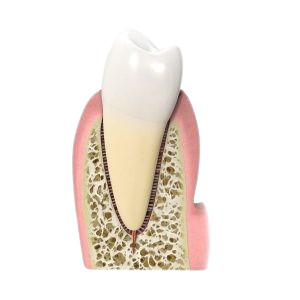Periodontal disease (Gum disease) is very common Condition affecting the teeth and its supporting Structures. (Foundation of your teeter). It is usually caused by plaque and calculus build-up around the gum live. For long time It may wit Cause any major problems. one can get subtle symptoms. Such as occasional gum bleeding, metallic trite or bad breath However, if left untreated it will cause early loss of Gum or all the teeth





Difference between healthy tooth and a tooth affected by advancing periodontitis
1 = gum 2 = bone 3 = periodontal ligament
If the inflammation spreads under the gums, it starts to destroy the teeth supporting structures (see fig. B). Such damages which may cause teeth to become loose and fall out are irreversible unless medical attention is sought.
Roughly 10% of the population is very resistant to gum disease. These people may have bleeding gums but nothing more than that.
On the other hand, approximately 10% of people are very susceptible to gum disease. This group is highly likely to develop symptoms of gum disease very early in life – loose and splayed teeth or bleeding and receding gums.
The remaining 80% of us is somewhere in between – more or less susceptible. For this reason you can hear all sort of stories – of those who never brush their teeth and still have them and those who always kept their teeth very clean but ended up losing them.
To be susceptible means to be more vulnerable to some disease and be prone to develop it easier. It doesn’t mean that you have to get it!
A lot can be done to keep the tooth in place. Often, getting the infection under control is all that is needed. If one cannot maintain the affected tooth clean on the day-to-day basis, it is possible to reshape the tissues around it in order to make it cleanable (small periodontal surgery). Where indicated we can encourage the body’s tendency to regenerate lost gum by employing the principles of ‘guided tissue regeneration’. It may be more appropriate to simplify the root’s shape and remove any non-functional root. There are also instances where patients come to the conclusion that it is more practical to remove the tooth and replace it with an implant, denture or a bridge. On our part, comprehensive analysis is crucial so that you make the right choice.
How ? why me?
We are all different people and some of us are more susceptible to plaque than others.
Susceptible patient’s gum gets easily inflamed when there is plaque close to it. Infection gets worse with inadequate brushing or when teeth are crowded. Gums of susceptible people get easily very ‘upset’ and become very inflamed, swollen and tender. The longer your gums are inflamed, the more damage will take place. Early diagnosis and focused treatment can arrest the disease and save your teeth.
In order to keep your gums healthy, it is very important that your teeth are kept very clean. Healthy gum is pink, doesn’t bleed and doesn’t look swollen


